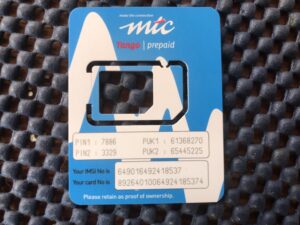Last Sunday we sailed into the Praia harbor. A welcome sight after a bit of an arduous journey. Literately twelve hours earlier we didn’t think we would make it to Praia on Isla de Santiago. We were fighting the wind and the current. For days the wind not bending to the northeast as was predicted and expected. Even the engine could not push us in the right direction. Well, it could, but it going flat out would give us less than a mile an hour and we don’t carry enough diesel for that kind of consumption. The waves were also against us, stopping us dead in our tracks.
At ten the night before, Ken and I were both in the cockpit, at the end of my watch, pouring over the weather grib files on our tablet and iPad discussing what to do next. Half an hour ago the winds had taken a turn to the wrong side of the spectrum and we were now squarely heading to the island of Fogo to the west of Santiago. This was not a problem in itself, we could anchor there. The problem is you can’t check in and out on Fogo. There are only three places in Cape Verde, a nation of ten volcanic islands, that facilitate the immigration and customs processes, Fogo not being one of them. So technically we could not go ashore if we landed there.
But then the wind died and the waves flattened. All in a matter of minutes. Isla de Santiago was in play again.
At seven on Sunday morning, we motored into the port of Praia and rafted up to an old fishing boat called Venus, which in turn was rafted up to an old derelict ferry. Rafting up was suggested to do to us, rather than anchoring out in the bay, by some sailors ahead of us for security reasons.
Apparently, people swim out at night and rob the sailors. Later on, we actually did anchor in the bay for a couple of nights with no incidents. That’s the problem with these stories. One person got probably robbed ten years ago and it is still front page news for the person sailing in today. Admittingly, the police also warned us about potential problems by anchoring out and strongly recommended we’d raft up again to Venus. Windsong and Venus don’t align very well and we’re worried that our solar panels are in danger of being ripped off when a gust of wind tilts us over a few degrees and we make contact with the old fishing boat. But so far so good.
Immigration was closed for the weekend, but the police at the port entrance saw no problem with us going into town. Most of the shops and the market were closed, but we had a few beers and some lunch while we tried to steady ourselves on the island that seemed to move underneath our feet. That’s just one thing that doesn’t get old, getting those land legs again. The beers, of course, were very beneficial for that.
The Cape Verde archipelago was uninhabited until the 15th century. Then the Portuguese came along and used it as a center for the Atlantic slave trade. The islands prospered during the 16th and 17th centuries, for all the wrong reasons of course, before its decline after the slave trade was abolished. The nation’s economy picked up again due to the island’s ideal location for re-supplying ships. Tourism, of course, is these days also a big boost to the economy.
Cape Verde was Charles Darwin’s first stop on his voyage on the Beagle in 1832.
The islands have very few natural resources and little agriculture. 90% of all foods are imported. However, the fruit and vegetable market here in Praia is absolutely amazing. I don’t think I have ever seen such a bountiful market anywhere in Africa and with such a wide variety. Granted, if you’re looking for broccoli or cauliflower, you’re in the wrong place. But even that is available, in the supermarket though, imported, limp, and small.
The winds are favorable for us right now. A weather window of opportunity opened up and this afternoon we’ll set sail for Mindelo. Hopefully, we can get some repairs done there. Although Mindelo is much smaller than Praia, it has a big marina and much better maintenance facilities for the yachting world.
Where is Steve?
I left Steve in Houtbay, just south of Cape Town on the 31st of January and I set sail with Ken and Maaike on the 14th of February. Steve recuperated and remained in South Africa until the middle of March. Judy flew out on the 1st of March. Remember, she flew in for 13 days on the 15th of January to go on a safari. So much for that.
Steve’s new crew is Wes. I know next to nothing about him, but I vaguely remember Judy saying something about a friend from home perhaps joining Steve. That could be him.
Steve departed from South Africa directly for St Helena. He was actually only one week behind us when we left St Helena. We had obviously gone to Namibia first. Steve was also unable to get to shore in Ascension and only spent four hours in the harbor before continuing on to Brazil.
Code Blue should arrive today, or already has, in Natal, Rio Grande do Norte on the mainland of Brazil. Steve has made good progress, good to see.
